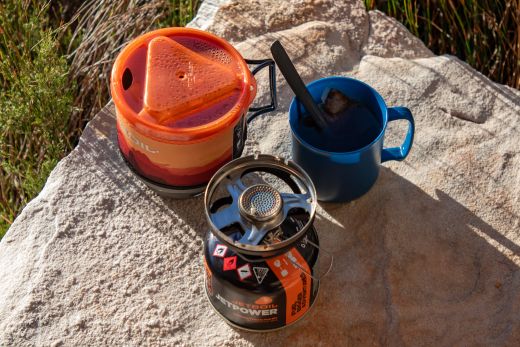From brewing coffee to rehydrating freeze-dried meals, your stove performs some pretty important tasks. But what makes any one stove better at a certain task, and how do you choose a stove for a certain activity? With a dizzying range of features, fuels, and designs, camping stoves are about as diverse as a single category of gear can get. And because of that, they have significant strengths and weaknesses. Some are very efficient until the temperature drops and they lose all pressure. Others work great in the cold but lose energy in the wind. Knowing the advantages, disadvantages, and best uses for these different types of stove is key to choosing one that will suit your needs. Fortunately, you’ve found this very comprehensive gear guide that lays out everything you need to know about your next camping stove.
- Factors affecting stove choice
- Stove features
- Types of stove
- Stoves for different activities
- Usage and care
Factors affecting stove choice
When choosing a new backpacking stove, it’s important to consider both performance and usability. Some stoves will be more fuel efficient, some will be more stable when cooking with a large pot, and some will pack smaller. No stove gets five stars for everything, and in weighing up the compromises, you’ll need to find a stove that meets all your priorities.
Performance
The power and economy of your stove will affect how much fuel you carry, how much it costs to run, and how quickly you can bring a pot of water to boil. But determining the performance of a stove is far from straightforward. Stove manufacturers like to quote boil times and fuel economy, but these need to be taken with a pinch of salt. Tests are conducted in lab conditions, and in the real world, factors like wind and temperature can have a big impact on a stove’s performance.
Temperature and altitude
Both altitude and low temperatures can lower the pressure in a canister, weakening a stove’s flame. In extreme conditions, hikers sometimes even have to store canisters inside a sleeping bag to keep them warm enough to be usable. Liquid fuel stoves, on the other hand, are pressurised manually with a primer, so if the pressure is too low, you just need to give several more pumps to get fuel flowing properly again.
Wind resistance
Wind resistance isn’t just a question of efficiency. Stoves with exposed burner heads can be so severely affected by even a light wind that they might not even be able to boil water. To combat this, some manufacturers have designed stoves with integrated pots and foil heat exchangers, which give them a level of wind resistance. Other types of stove have to be shielded from the wind with a windshield or windbreak.
| Alcohol | 1.1 L |
| White gas | 1.3 L |
| Canister fuel (compact stoves) | 2.2 L |
| Canister fuel (integrated stoves) | 2.9 L |
This above table shows how much water can be boiled with 28 g (1 oz) of fuel under ideal conditions. Figures shown are averages for stoves in these categories.
Features and usability
Even a powerful and efficient stove can be a poor choice if it lacks the features and properties that would meet your needs. To ensure that your stove is up to the task, it’s important to consider packed size, weight, stability and features such as temperature control and ignition.
Packed size
If you carry a small pack (fastpackers and bikepackers), you’ll also want to keep bulk down as much as possible. It makes sense that lightweight stoves are also compact, but it’s also worth considering how your stove, fuel bottle or canister, pack together. Many integrated systems are designed so that the canister fits inside the pot. Likewise, many standalone pots are designed to carry both canister and stoves – a very effective space-saving strategy. The same cannot be said for liquid fuel systems.
Weight
Stove weight is important if you’re trying to go light, but comparing weight can be tricky. You can’t compare integrated stoves to standalone stoves unless you also include the weight of a pot. And you can’t compare stoves that run on different fuels unless you also consider the weight of the fuel needed for a certain amount of cooking. For example, alcohol stoves use more fuel than canister stoves, which can negate the low weight of an alcohol stove over a longer trip.
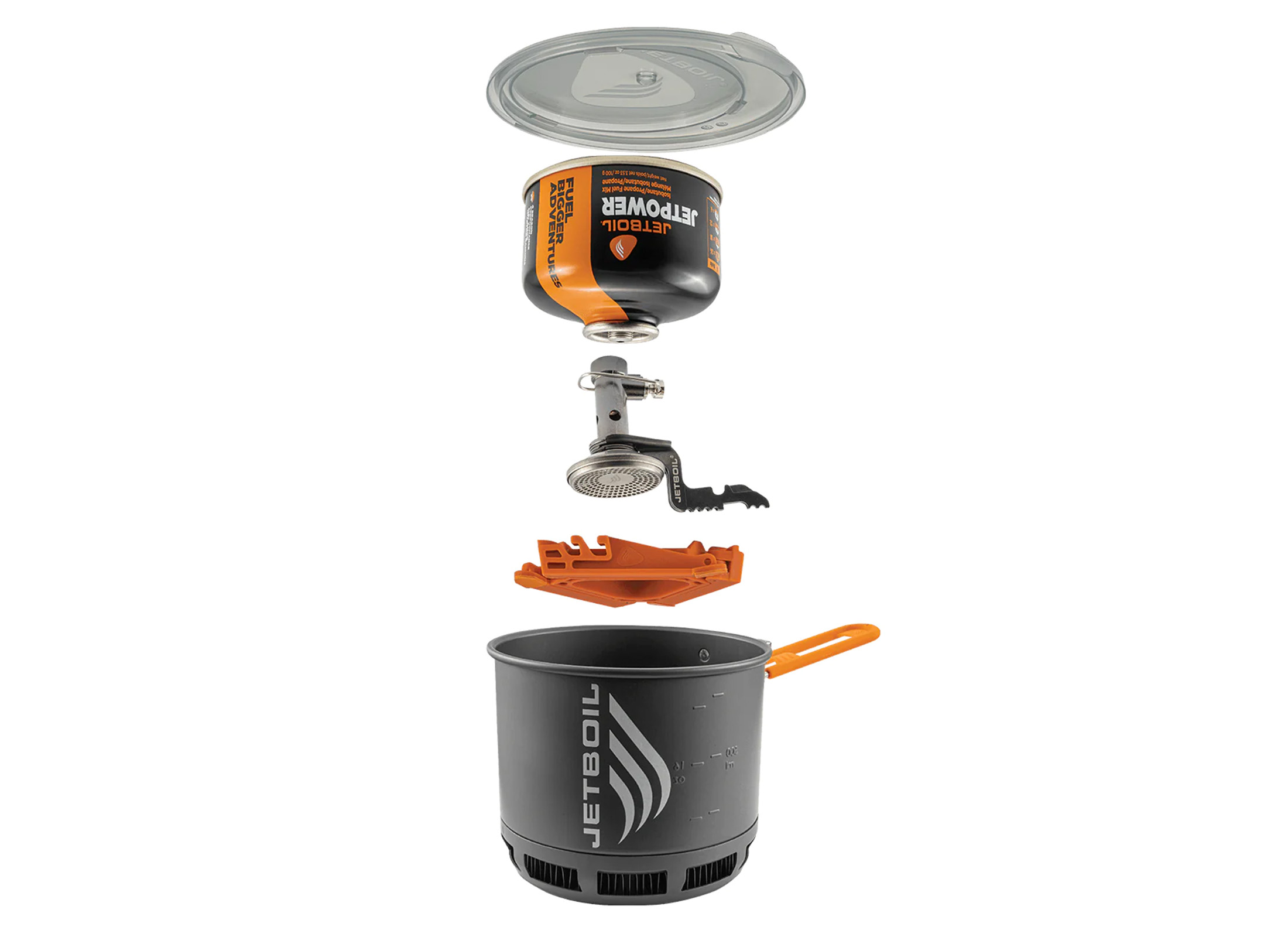
Piezoelectric lighter
These push-button spark producers were once found only on more sophisticated stoves, but today there’s little reason to go without one. Besides making your stove easier to use, a piezoelectric lighter gives you a second means of ignition if your matches get wet or lost Yes, you should still carry a second means of ignition. Flint strikers are generally a lot more reliable than matches or lighters, which can fail when wet or damaged.
Temperature control
Any stove will boil water, but not all stoves are designed for allround cooking. Without a variable flow valve to turn the heat down, your stove will burn your pancakes and scorch your oatmeal. If you intend to cook anything beyond noodles or freeze-dried meals, look for a model with good flame control, especially at the low end of output. Also know that pots made from aluminium are better for cooking than those made from stainless steel or titanium.
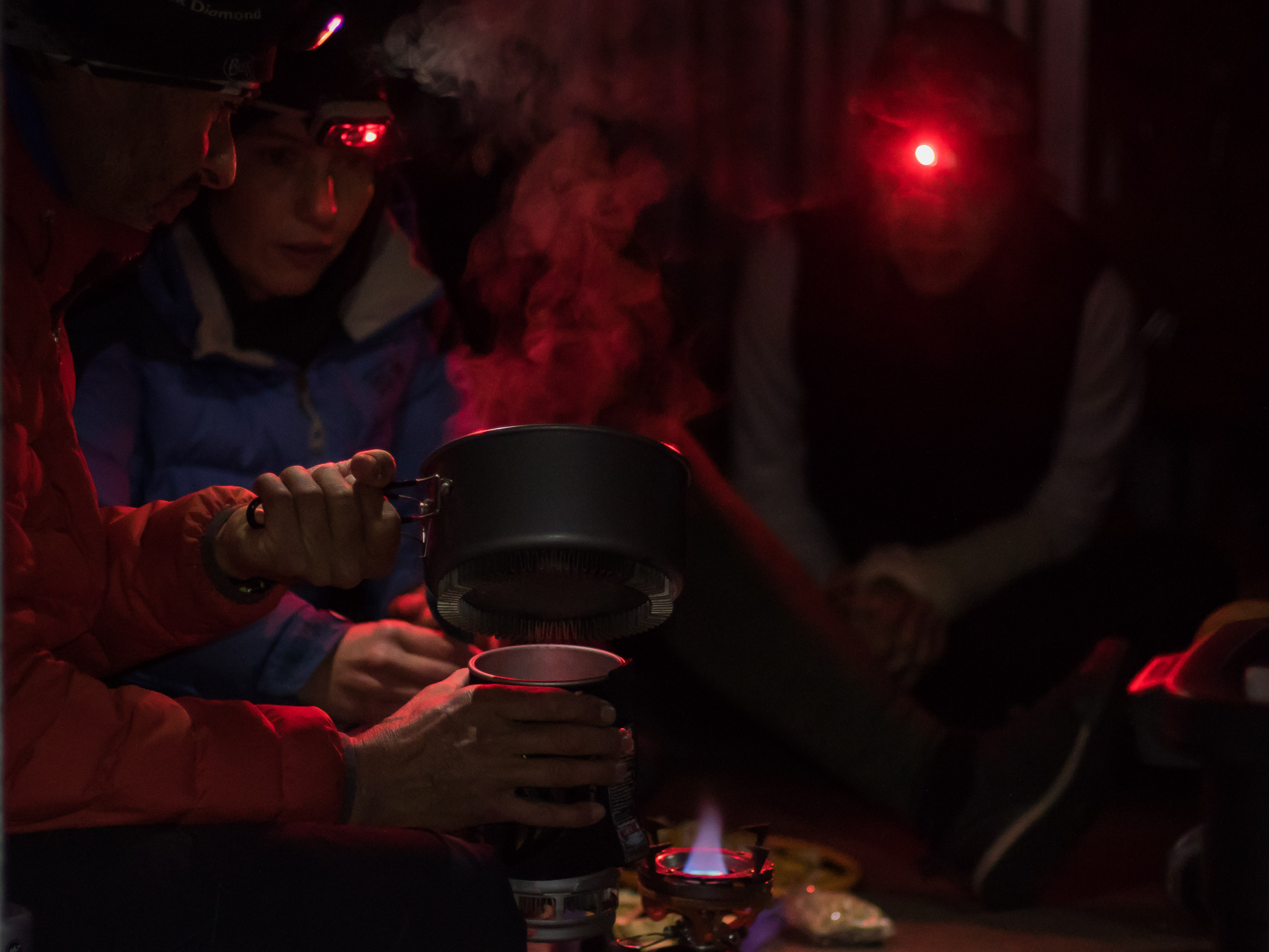
Burner head and heat distribution
Burner head size becomes important in two instances: when using a small pot and when doing real cooking (not just boiling). A wide burner head will send flames up the side of a small pot, while a narrow burner head is likely to produce a very focussed flame and uneven heat distribution, which can result in burned food. A good allround stove will achieve a balance between these two extremes.
Cooking surface and stability
Integrated stoves can be a little top heavy, but then their pots are also locked to their burners, eliminating any risk of the cooking vessel wobbling off the cooking surface. Stability is more of a factor when choosing a standalone stove for a large pot. If you’re going to cook for large groups, consider the size of the cooking surface and how easy it will be to balance a big pot on it. Some compact canister stoves and alcohol stoves would be unsuitable for such a task.
Pot
On integrated stove systems, a wide pot is important if you plan to use the pot as a bowl since it’s much easier to spoon food out of a wide pot than a narrow one. It’s also easier to cook in a wider pot for the same reason.
Fuel availability
You’ll find fuel canisters almost anywhere in the world where there is a large outdoor community, but that doesn’t mean you’ll be able to stock up in the middle of an extended trip. In many developing countries, you’ll only find outdoor stores in the biggest cities, and in some countries, you won’t be able to find them at all. Of course, you also can’t fly with pressurised canisters, and so your best option in many cases will be to pack a liquid gas stove which can run on a range of fuel types. Denatured alcohol is also widely available although it will be known by other names in some countries (more about that later).
Types of stove
Stoves are usually categorized according to fuel type, as this is the largest factor determining performance. Noting the disadvantages and advantages of each of these is generally a good first step for shortlisting candidates, since it can guide you towards a stove design that suits your needs. Just bear in mind that even models within the same subcategory (like integrated canister stoves) can still vary in terms of features and performance.
- Canister stoves
- Liquid fuel stoves
- Alcohol stoves
Canister stoves
With designs ranging from ultralight standalone stoves to fully-featured integrated models, canister stoves are by far the largest and most varied category of stove. I say ‘category’ and not ‘type’, because the only thing that some of these stoves have in common is that they run on canisters containing a mix of propane and either butane or iso-butane. This type of fuel gives canister stoves their characteristic advantages and disadvantages.
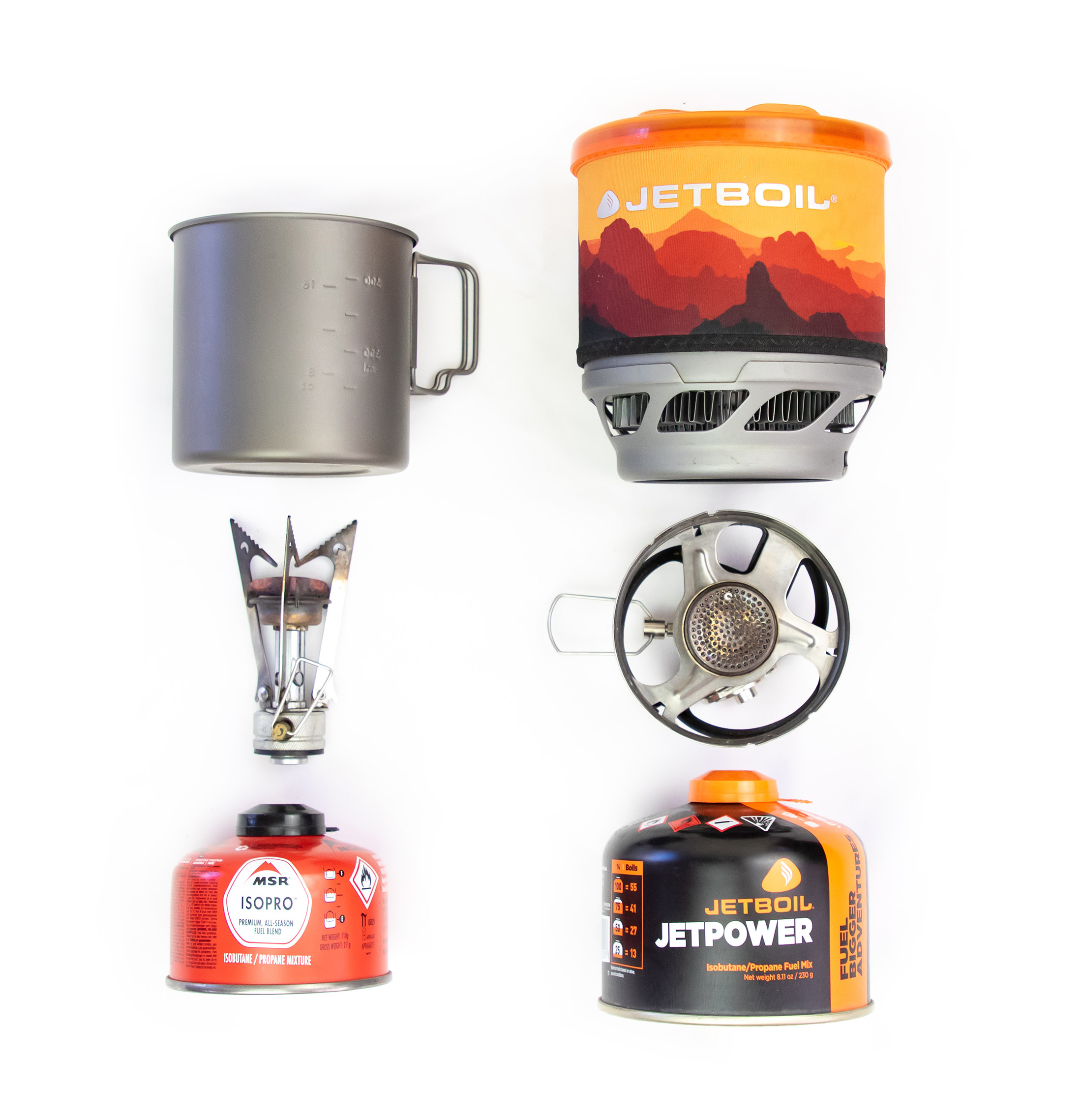
| Pros | Cons |
|---|---|
| Light and compact | Difficult to judge fuel level |
| flame control for simmering (most) | Canisters have to be thrown away |
| Easy to use | Canisters are not widely available abroad |
| Canisters self-seal when detached | Canisters can depressurise in cold temps |
| More costly than liquid fuel |
Light, compact, easy to use
The main advantage of canister stoves is that they’re light and compact. The lightest models weigh as little as 28 grams (1 oz), and many are designed to fit into a pot with their canisters, although this space-saving strategy has as much to do with pot design as it does with a stove. The other reason that canister stoves are so popular is that they’re easy to use. Unlike liquid fuel stoves, which require priming and preheating, firing up a canister stove can be as simple as screwing the stove onto the canister, opening the tap, and pushing the piezo lighter.
Poor low-temperature and high-altitude performance
The disadvantage of canister stoves is that they don’t perform well in low temperatures, which lowers the relative pressure inside a canister, weakening the fuel flow and flame. In the most challenging conditions, a stove will quickly burn off the more combustible propane, leaving you with a half-full canister of useless butane. There are ways to remedy this problem (see usage tips below), and at least one manufacturer has come up with a design solution: inverted remote canister stoves. But these are less compact than traditional canisters, making them more similar to liquid fuels stoves in some ways.
Canister compatibility and availability
Canisters are available in 110 g (4 oz), 227 g (8 oz), and 450 g (16 oz) sizes, and are compatible across brands, despite what manufacturers say. As the most popular type of stove fuel, these are available in many places but not everywhere. You’ll find them in developed countries like those in North America and Europe, and in popular trekking and climbing regions like the Himalayas and Andes. But, if you’re planning a trip well off the beaten track, it would be wise to go with a multi-fuel stove (see liquid fuel stoves below) that can run on locally available fuels. For more information on fuel availability around the world, see this guide by MSR.
Compact canister stoves
These are the direct descendents of the first canister stoves. They are the lightest, simplest and most robust of all the pressurised-fuel stoves. Besides being very popular with the ultralight crowd, these little flamethrowers are also popular with backpackers who prefer the versatility and simplicity of a standalone stove over an integrated system. If you go with one of these stoves, you might want to look for a piezo lighter and variable heat control. Some models have simmer control; others don’t.
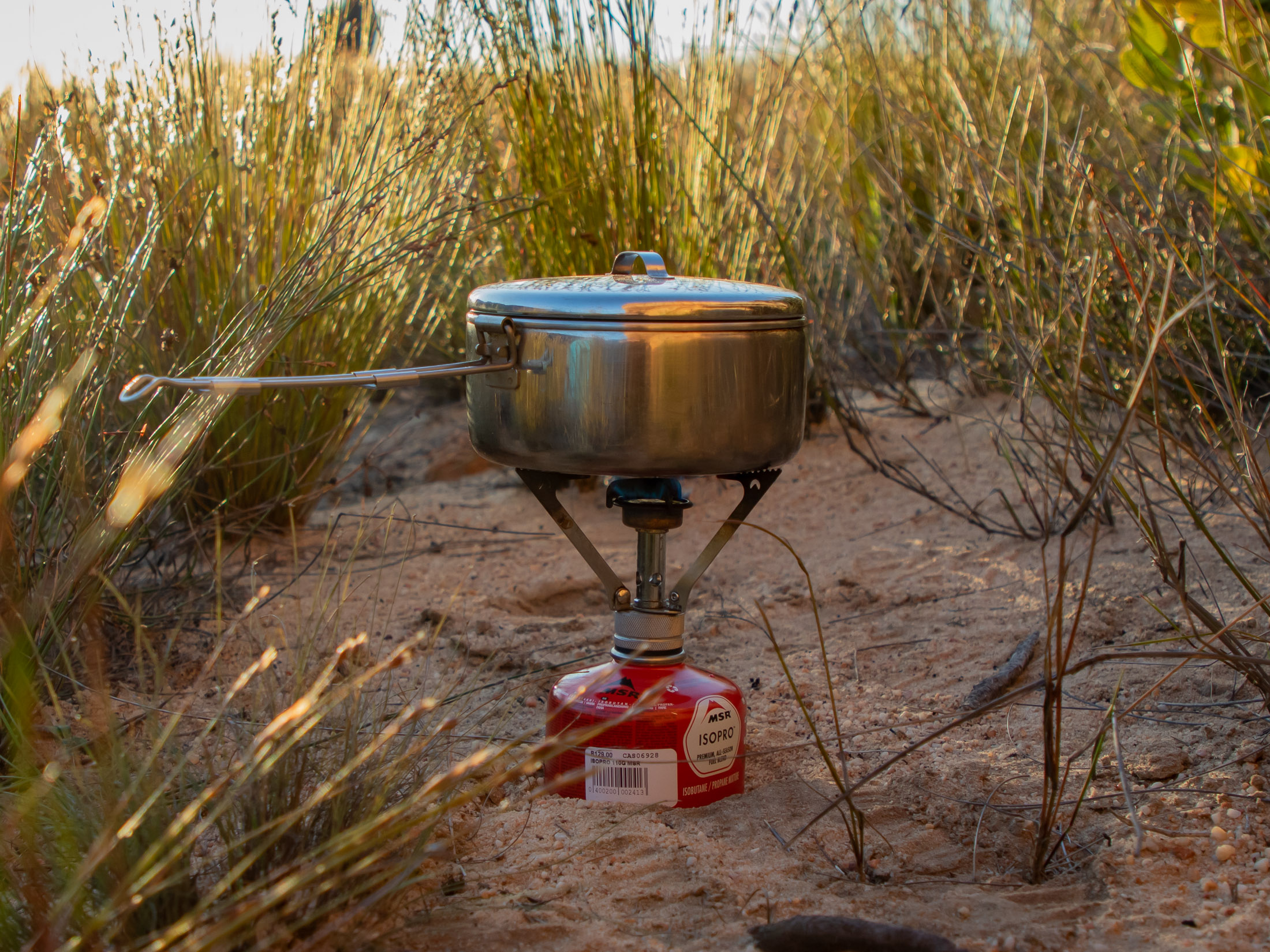
As popular as they are, compact canister stoves are not without their weaknesses. They lag behind integrated stoves in two ways: wind resistance and fuel efficiency (the former affects the latter). Because the burner heads on standalone stoves are exposed, they tend to waste energy in even a light breeze. And, unlike liquid fuel and remote canister stoves, compact canister stoves cannot be surrounded with a windscreen. Doing so can cause the canister to heat up and even explode. To shield a canister stove, you can create a windbreak on one side of the stove, but you must ensure that there is enough ventilation to prevent heat buildup.
| model | weight | piezo lighter | heat control |
| BRS 3000T Ultralight Stove | 28 g / 1oz | No | ★ |
| MSR PocketRocket 2 | 72 g / 2.6 oz | No | ★★ |
| MSR PocketRocket Deluxe | 82 g / 2.9 oz | Yes | ★★★ |
| Soto Amicus | 77g / 2.7 oz | No | ★★★ |
| Snow Peak LiteMax | 57 g / 2 oz | No | ★★★ |
| Snow Peak GigaPower 2.0 | 91 g / 3.2 oz | Yes | ★★★ |
★ for heat control means there is no simmer control.
Compact canister stove kit
When I carry a canister stove, I usually want to be able to cook with it and not just boil water. So, while a titanium pot would be lighter, I usually pack an aluminium pot, which ensures better heat distribution and reduces the risk of burned porridge. If you were only planning to boil water for coffee or dehydrated meals, you could go with a titanium pot and bring the total weight down by 85 g (3 oz) or so. A single 110 g (4 oz) canister is usually enough for about nine boils (1 litre each), while a 227 g (8 oz) canister, as specified in this kit, will last for around 18 boils. To ensure this level of economy, you need to shield your stove from wind as much as possible, remembering that you can’t fully surround it with a windshield.
| MSR PocketRocket 2 | 74 g / 2.6 oz |
| MSR Trail Mini Solo Cook Set | 203 g / 7.3 oz |
| 227 g / 8 oz canister | 369 g / 13 oz |
| Total weight | 646 g / 22.8 oz |
Integrated canister stoves
Integrated stove systems are designed with a pot that attaches to the stove using a twist-on mechanism. This approach allows a foil heat exchanger and wind protector to be built into the base of the pot, improving both wind resistance and overall fuel economy by about 33%. The downside to this design is that it makes a stove taller and less stable, even when you’ve attached the snap-on legs. The other minor drawback to integrated stoves is that they’re also heavier, although to make a fair comparison, you’d have to compare the weight of an integrated stove to a standalone stove and its pot.
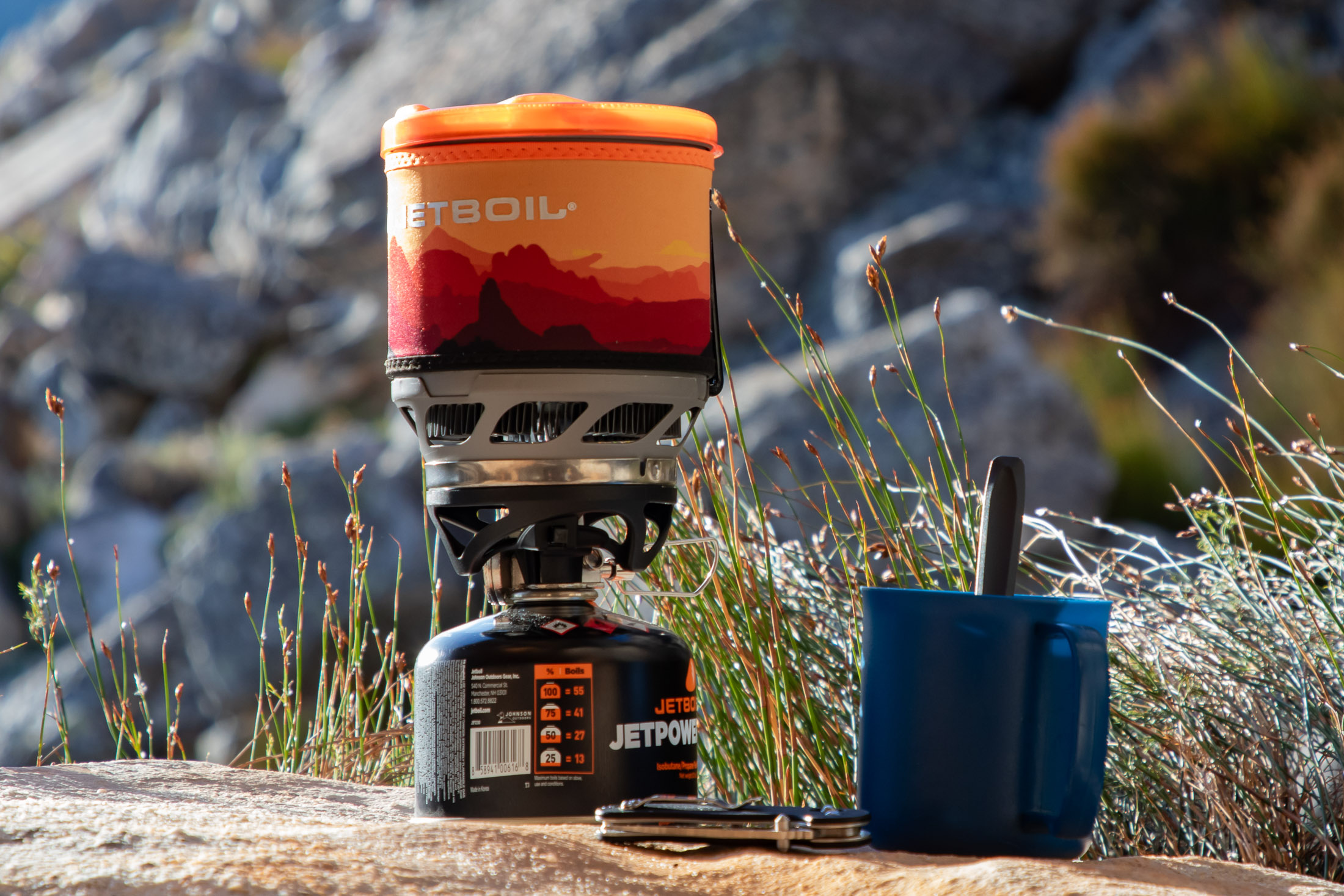
For example, the Jetboil MiniMo weighs 415 grams (14.6 oz), and the MSR Pocket Rocket with Trail Mini Solo pot weighs 290 grams (10.2 oz) combined. That’s only a 125 gram (4.4 oz) difference. You’d have to be an incurable ounce counter to discount the integrated stove and its advantages just because it incurred a 30% weight penalty. What would be more of a deal breaker for me is a lack of simmer control. The Jetboil MiniMo can do this, but not all models allow you to turn the flame down. Again, if I’m going to carry a canister stove, I want to be able to do more than just boil water.
| model | weight (including pot) | pot size | piezo light | heat control | wind resistance | price |
| Jetboil Flash | 371 g / 13.1 oz | 1.0 L | Yes | ★ | ★★★ | $110 |
| Jetboil MiniMo | 414 g / 14.6 oz | 1.0 L | Yes | ★★★ | ★★★ | $150 |
| Jetboil MicroMo | 340 g / 12 oz | 0.8 L | Yes | ★★★ | ★★★ | $145 |
| MSR Windburner Personal | 439 g / 15.5 oz | 1.0 L | No | ★★ | ★★★★ | $150 |
| MSR Reactor 1.0LTR | 133 g / 14.7 oz | 1.0 L | No | ★ | ★★★★ | $210 |
★ for heat control means there is no simmer control.
Integrated canister stove kit list
There’s not much to an integrated canister stove kit beyond the stove and canister, and I include the table below only for the sake of weight comparison. Integrated canister stoves are around 30% percent more efficient than standalone models, meaning that a 110g (4oz) fuel canister will get you around 12 boils while a 227g (8oz) canister, as specified in this kit, will be good for around 24.
| Jetboil MiniMo | 414 g / 14.6 g |
| 227 g / 8 oz canister | 369 g / 13 oz |
| Total weight | 783 g / 27.6 oz |
Remote canister stoves
Although these stoves run on canister fuel, they look more like liquid fuel stoves in that they sit on the ground and are connected to the fuel source with a hose. Why complicate things like this? Well, firstly, it allows campers to use windscreens to shield their stoves – there’s little to no chance of a canister heating up when there’s so much space between it and the stove. And secondly, it allows the canister to be mounted in an inverted position, which vastly improves low temperature performance.
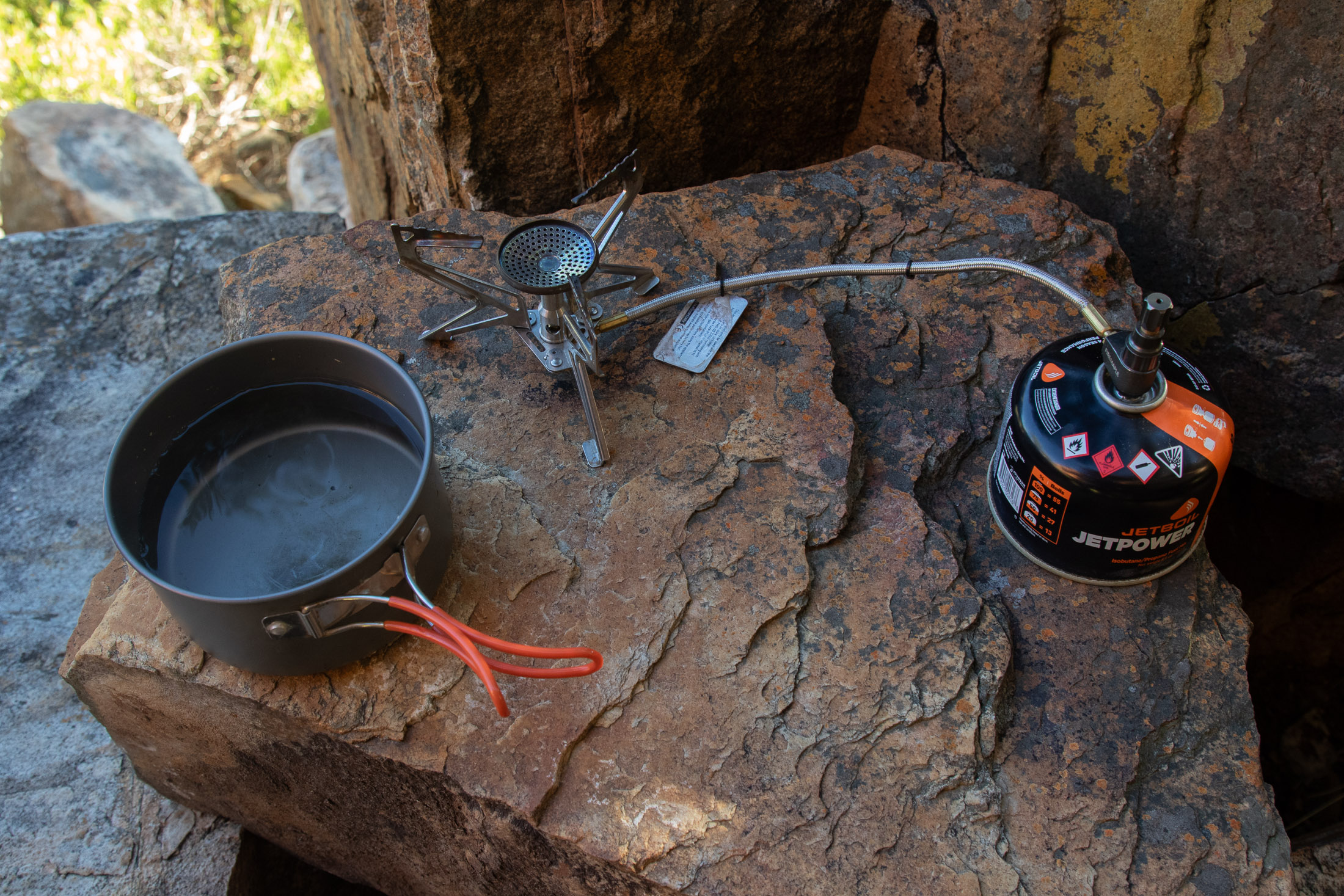
Both adaptations make remote canister stoves a good choice if you want the simplicity of a canister stove but still want to use your stove in challenging conditions. The second stove on this list can use both canister fuel and liquid fuel, making it a hybrid. Both models are given only two stars for heat control because inverting a canister increases pressure at a cost to simmer control. Personally, I’d sooner carry an integrated canister stove or liquid fuel stove if conditions demanded it. Having to pressurise a stove manually doesn’t bother me.
| model | weight | piezo lighter | heat control | price |
| MSR WindPro II | 187 g / 6.6 oz | No | ★★ | $100 |
| MSR WhisperLite Universal | 318 g / 11.2 oz | No | ★★ | $140 |
Liquid fuel stoves
Liquid fuel stoves perform well even in freezing conditions and at high altitude, making them firm favourites with mountaineers and other adventurous types who need their stoves to work in challenging conditions. But these stoves aren’t just for Everest summits and polar expeditions. The wide and stable base of a liquid fuel stove makes this type of stove a good choice for cooking with a big pot, and the low cost of white gas means that they’re a lot cheaper to run than canister stoves. These advantages make this reliable workhouse stove very popular with guides and school outdoor programmes.
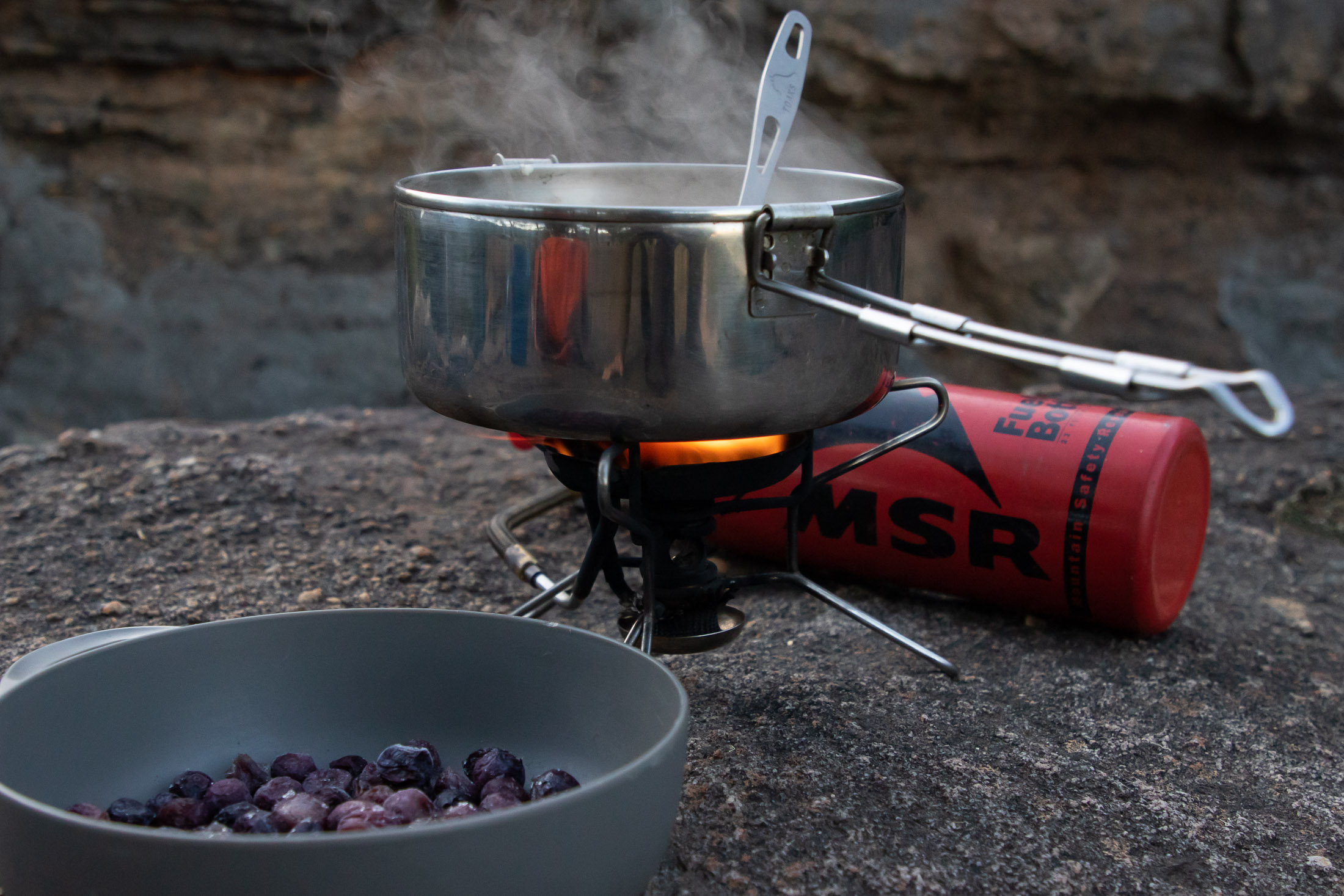
| Pros | Cons |
| Low profile and stable | Requires priming and preheating |
| Perform well in low temps and at altitude | More complex than a canister stove |
| No canister to discard | Require maintenance |
| Fuel is cheap |
Good low-temperature and high-altitude performance
The biggest advantage of a liquid fuel stove is all-weather performance. Cold temperatures lower the pressure in any fuel container, rendering most canister stoves useless in very cold conditions. Liquid fuel stoves get around this problem by making the operator responsible for generating pressure inside the fuel bottle. So, yes, you have to prime a stove before you can use it, but then you also have complete control of how much pressure you have in the fuel bottle. When temps drop, you just need to give several more pumps to get your stove working properly again.
Weight considerations
Some gearheads have claimed that the low weight of liquid fuel bottles (compared to canisters) means that a liquid stove kit can weigh less than a canister kit when you need a lot of fuel. But the math suggests otherwise. Canisters are indeed heavy relative to the fuel they contain – 142 grams for 227 grams (8 oz) of fuel. But the difference in fuel economy (canister fuel is roughly twice as efficient) cancels out any weight savings that might be realised when carrying liquid fuel in a lighter container. A 30 oz bottle of white gas weighs a total of 845 grams while the equivalent canister (450 g / 16 oz) weighs only 645 grams and is capable of a few more boils.
Multi-fuel versatility
Most campers run their stoves on white gas (also known as camping gas) since it’s relatively clean, but liquid fuel stoves can also run on kerosene, unleaded petrol (gasoline), or diesel. Such versatility makes it a lot easier to find fuel when your closest gear store is several hundred kilometers away – a real possibility in less developed countries. In the past, campers had to change burner nozzles when swapping from one type of fuel to another, but newer multi-fuel stoves can burn three or four different fuels through the same nozzle. And at least one innovative model, the MSR Whisperlite Universal, allows you to swap the fuel bottle for a canister, giving you even more options.
Maintenance
With no moving parts and a short, simple fuel line, canister stoves require almost zero maintenance. Liquid fuel stoves are a lot more complex, and they run on fuel that can leave deposits in the fuel line if not cleared. This doesn’t have to be done more than a couple of times a year, and is not particularly difficult – manufacturers have produced videos that make the maintenance easy. So it shouldn’t be a detractor for most people. Note that some manufacturers and retailers advise against using unleaded petrol as your regular fuel since it burns dirtier than kerosene or white gas.
| model | weight | heat control | price |
| MSR WhisperLite International | 309 g / 10.9 oz | ★★ | $140 |
| MSR XGK EX | 489 g / 17.2 oz | ★★ | $160 |
| MSR Dragonfly | 400 g / 14 oz | ★★★ | $140 |
| Primus OmniFuel | 326 g / 11.5 oz | ★★★ | $160 |
| Optimus Nova+ | 383 g / 13.5 oz | ★★★ | $150 |
Liquid fuel stove kit
In this kit I’ve specified a two-litre pot, as you’d use when catering to a large group, but you can swap this out for a one-litre model and bring the total weight down to 1127 grams – around 480 grams heavier than a compact canister stove kit. With regards to fuel economy, 30 ml (1 oz) of white gas will boil one litre of water in favourable conditions. So a 20 oz bottle will be good for around 20 boils. Just remember that if you plan to use your stove in very cold conditions or at altitude, you will need more fuel. How much? Read my article on how much fuel to carry, and you won’t have to guess.
| MSR WhisperLite International | 309 g / 10.9 oz |
| MSR Trail Lite 2L pot | 250 g / 8.8 oz |
| Foil windshield | 28 g / 1 oz |
| 590ml / 20oz fuel bottle with fuel | 587 g / 20.7 oz |
| Total weight | 1174 g / 41.4 oz |
Alcohol stoves
With the average alcohol stove weighing in at under 60 grams (2 oz), these are by far the lightest stoves, making them a good option for solo hikers, fastpackers, and other adventurers who need to keep weight down. Just know that if you take this ultralight approach, you’re going to give up some performance and functions. This type of stove is best reserved for trips that involve warm weather and minimal cooking. The higher than average consumption rate of alcohol means that the weight advantage of these little stoves is nixed when you do a lot of cooking or go several days between resupplies.
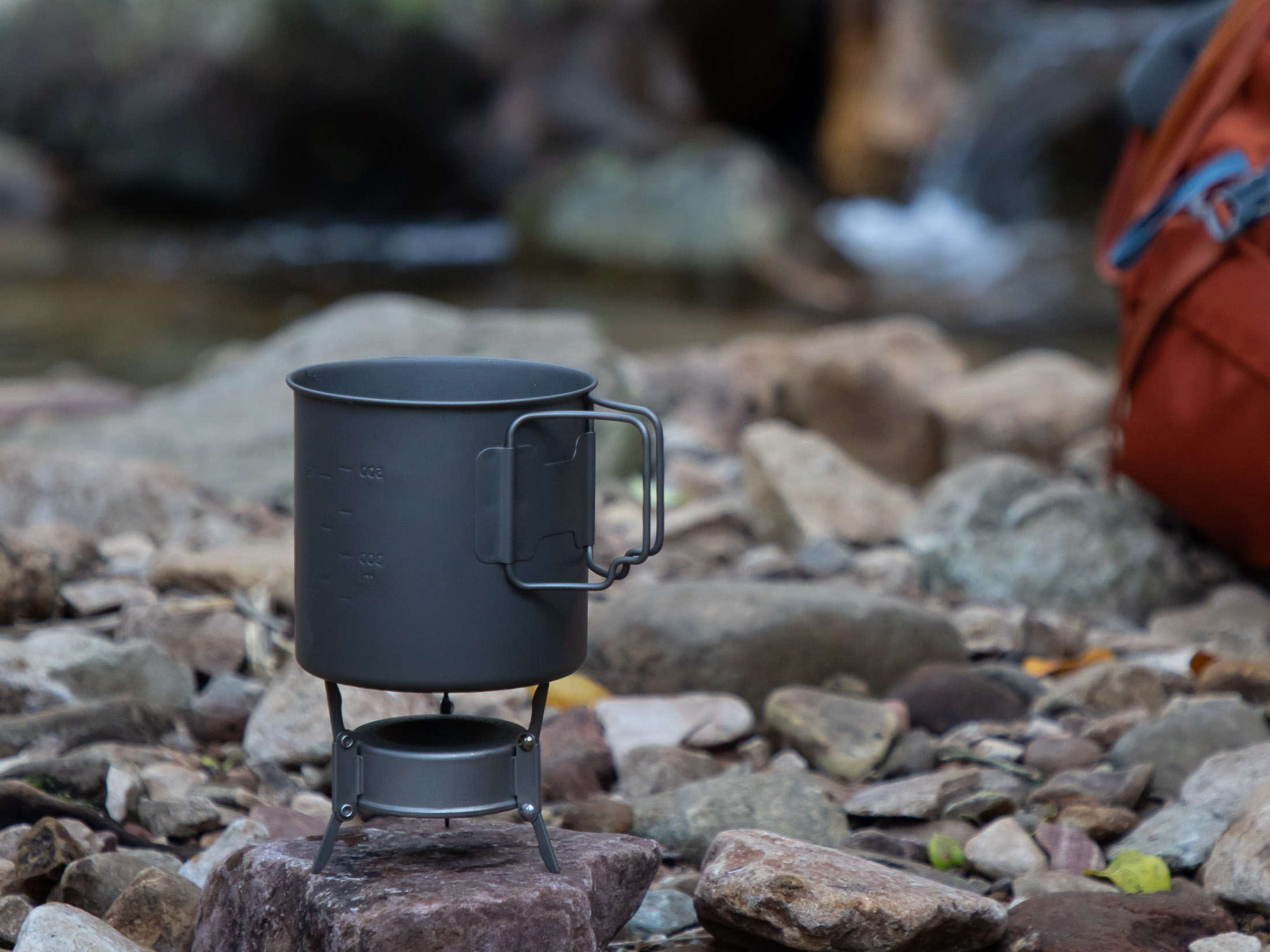
Note: Alcohol stoves are not allowed during open flame bans like those enforced in the North American West in the hotter and drier summers of recent years.
| Pros | Cons |
| Very light | Flame not as strong as other stoves |
| Burns silently | Requires a windscreen |
| Fuel is easy to find | Suitable only for warm, mild conditions |
| Cheap |
Weight advantage on shorter trips
Once a trip extends beyond a certain duration – three to five days depending on conditions and how much cooking you’re doing – the weight advantage of a light stove is offset by the weight of the fuel, which burns less efficiently than canister fuel. A weekend’s worth of fuel (150 ml / 5 oz) puts the total weight of a light alcohol stove kit at about 320 grams (11.3 oz) – 230 grams lighter than a canister stove kit with a 110 g (4 oz) canister. But five days worth of fuel (360 ml / 12 oz) will put your kit weight at 507 grams (18 oz) – only 140 grams lighter than the aforementioned canister stove kit, which is also capable of producing 10 boils.
Lower output and poor cold temperature performance
Since alcohol stoves don’t have a fuel delivery system, they only have only two settings – on and off – and cannot be used for simmering. They also don’t burn as hot as pressurised stoves and are a poor choice for cold temperatures or trips where you have to do a lot of cooking or boiling. In temps below -6°C or 20°F, they might not even get water to boil. When carrying an alcohol stove, always carry a windscreen to ensure that you get a decent flame out of it.
Fuel availability
In terms of availability, denatured alcohol can be found all over the world although in some countries it’s called methylated spirits and is dyed blue (presumably to prevent people from accidentally drinking it). Alcohol stoves can also run on two fuels produced by a brand called HEET. These alternatives are commonly known as Yellow HEET and Red HEET. Yellow HEET burns more cleanly than the red stuff and is a lot more popular. If using clear spirits, It’s a good idea to mark this as fuel so that one of your trail partners doesn’t take a swig thinking that it’s tequila or something else more fun.
Home-made stoves
Most advocates prefer to make their own stoves out of used soda cans – easy enough when the internet is awash with DIY tutorials. But if your art and craft skills aren’t up to snuff, or you just couldn’t be bothered, you can buy a denatured stove for the princely sum of $20. Besides that, all you need is a bottle of the appropriate size.
| model | weight | price |
| Whitebox | 30 g / 1 oz | $20 |
| Vargo Triad | 30 g / 1 oz | $35 |
| Evernew | 34 g / 1.2 oz | $37 |
| GoBag | 57 g / 2 oz | $25 |
| Trangia Spirit Burner | 110 g / 3.9 oz | $15 |
Alcohol stove kit
For solo and ultralight adventures like fastpacking and bikepacking, I usually carry an alcohol stove with 250 milliliters (8.5 oz) or less of fuel – enough for about 8 boils. Since, simmering isn’t really an option with an alcohol stove, there isn’t much point in carrying an aluminum pot, so I usually opt for lighter titanium cookware. Like liquid fuel stoves, alcohol stoves should be used with a windshield if there is even the slightest breeze. But, unlike liquid fuel, alcohol can be stored in regular screwtop plastic bottles, which allows you to size up or down according to how much fuel you need to carry. This and the fact that plastic is lighter than metal means that you can save a significant amount of weight on fuel storage.
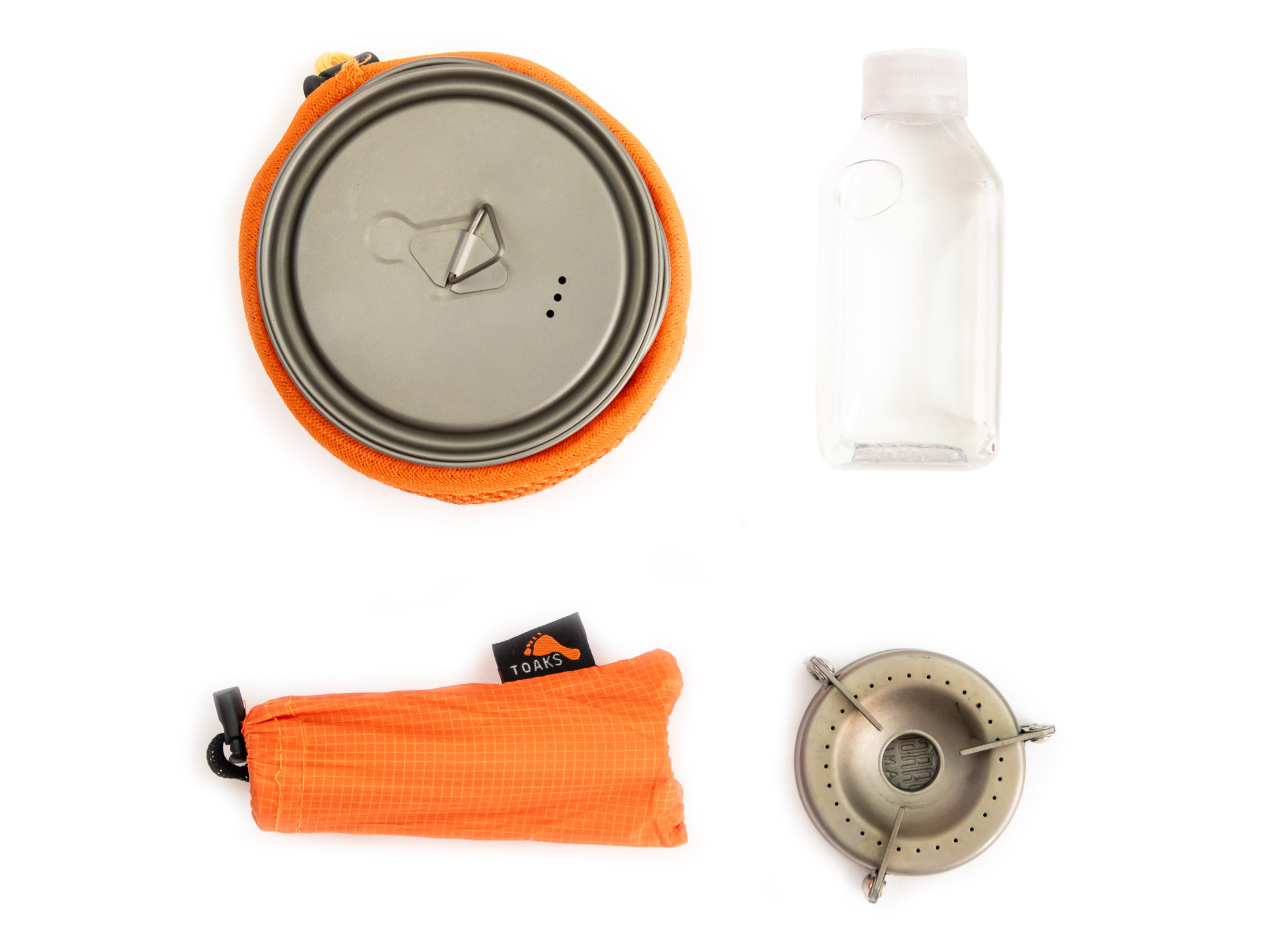
Note: Alcohol stoves have to be primed, meaning that the denatured alcohol first has to be warmed to a point where it vaporises. This can also affect the amount of fuel one uses.
| Vargo Triad | 30 g / 1 oz |
| Vargo aluminium windshield | 38 g / 1.3 oz |
| Vargo Ti-Lite 750 Mug | 117 g / 4.1 oz |
| 240ml / 8oz alcohol in plastic bottle | 215 g / 7.6 oz |
| Total weight | 400 g / 14.1 oz |
Stoves for different activities
Some outdoorsmen might own several stoves for different purposes, while others will want only one stove to do it all. Regardless of your strategy, it’s important to know what you’re going to ask of your stove so you can choose one that best serves your needs.
Weekend backpacking
On short trips that require only a little cooking, an alcohol stove will suffice. But if you plan to do a significant amount of cooking and want to do more than just boil water for freeze-dried meals, you'll need something more versatile. The best allrounder is a canister stove, and while you might save some weight on a compact model, an integrated canister stove like those made by Jetboil will serve you better in cold and windy conditions. To get the most out of your stove, choose one that has simmer control.
Fastpacking, ultralight backpacking, and bikepacking
Amongst ounce counters, the choice is usually between an alcohol stove and a compact canister stove. Alcohol stoves can help solo adventurers keep down their pack weight, but they’re best reserved for shorter trips and those where resupplies are less than five days apart. Carrying more fuel than that will negate the weight savings of an alcohol stove. You might also want to go with a light canister stove if you need to do more than just boil water. Regardless of the type of stove, look for a narrower burner head and flame – one that won’t lick up the side up the side of a small pot.
Thru-hiking
As I’ve just pointed out, much of your decision will hinge on two factors. The first is whether you’ll be travelling solo (carrying the entire cook kit yourself) or sharing it with a partner. The second is the distance between resupplies. It doesn’t make sense to carry an alcohol stove when you need to start every leg with 470 ml (16 oz) or more in alcohol fuel. For the weight of such a kit, you could carry a simmer-enabled canister stove with 227g (8 oz) of fuel – enough for just as many boils. And that begs the question – Can you really go for a month (or months) eating nothing but rehydrated meals.
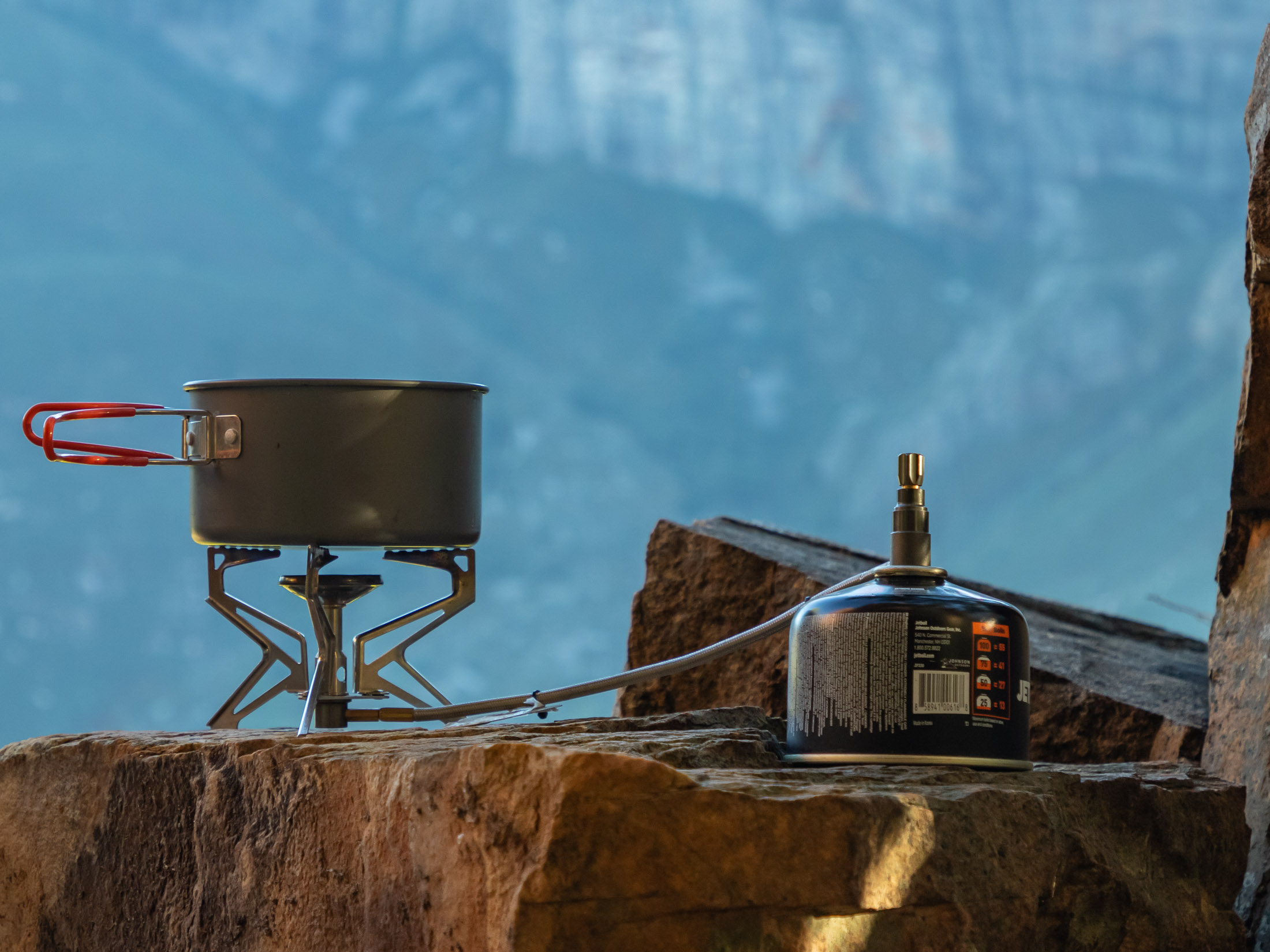
Alpine climbing
You want to go fast and light, but in the mountains you need to be prepared for both high winds and low temps. Integrated canister stoves like the MSR Reactor tick the boxes for wind resistance and light weight, but they can underperform in low temps. To ensure that they can get a decent flame out of a canister, alpine climbers will often wrap their canisters in a sleeping bag or insulated jacket, which does the trick most of the time. The alternative is to go with a liquid fuel stove, a solution that trades weight and convenience for all-round performance.
Mountaineering
Higher elevations mean even colder conditions, and mountaineers need to be prepared for temperatures that regularly drop to well below freezing. Their stoves need to be powerful enough to melt snow and cook for larger groups. Liquid fuels stoves are the only option here, and many experienced mountaineers will go with nothing less than a fully-featured expedition stove (see MSR’s XGK). These reliable and fast burning stoves are heavier than almost any other ‘light’ stove, but their improved fuel efficiency in cold and thin air can make them weight savers in the most challenging conditions.
Usage and care
After laying down your hard earned money for a new stove, there are a few things you can do to get the most out of your new kit and keep it running smoothly for years.
All stoves
Economy flame
In average conditions, most stoves will be most economical with the flame turned down to around 70%. Your water will take a little longer to boil, but you’ll save a significant amount of fuel in the long run.
Tent cooking
With the risks of monoxide poisoning and fire, cooking in a tent can be dangerous. Only attempt this if you have to, and then take every precaution to ensure adequate ventilation and prevent accidents. Tip: integrated stoves are best for this, since there is little to no naked flame.
Beware titanium pots
Titanium pots are light and strong, but they don’t distribute heat well, making them a poor choice for cooking in. If you don’t want to burn your oats, aluminium is a much better material.
Carry a lighter or flint striker
Piezoelectric lighters have become a lot more reliable, but you should still carry a lighter or flint striker even if your stove has electronic ignition. There’s no need to put Murphy’s law to the test.
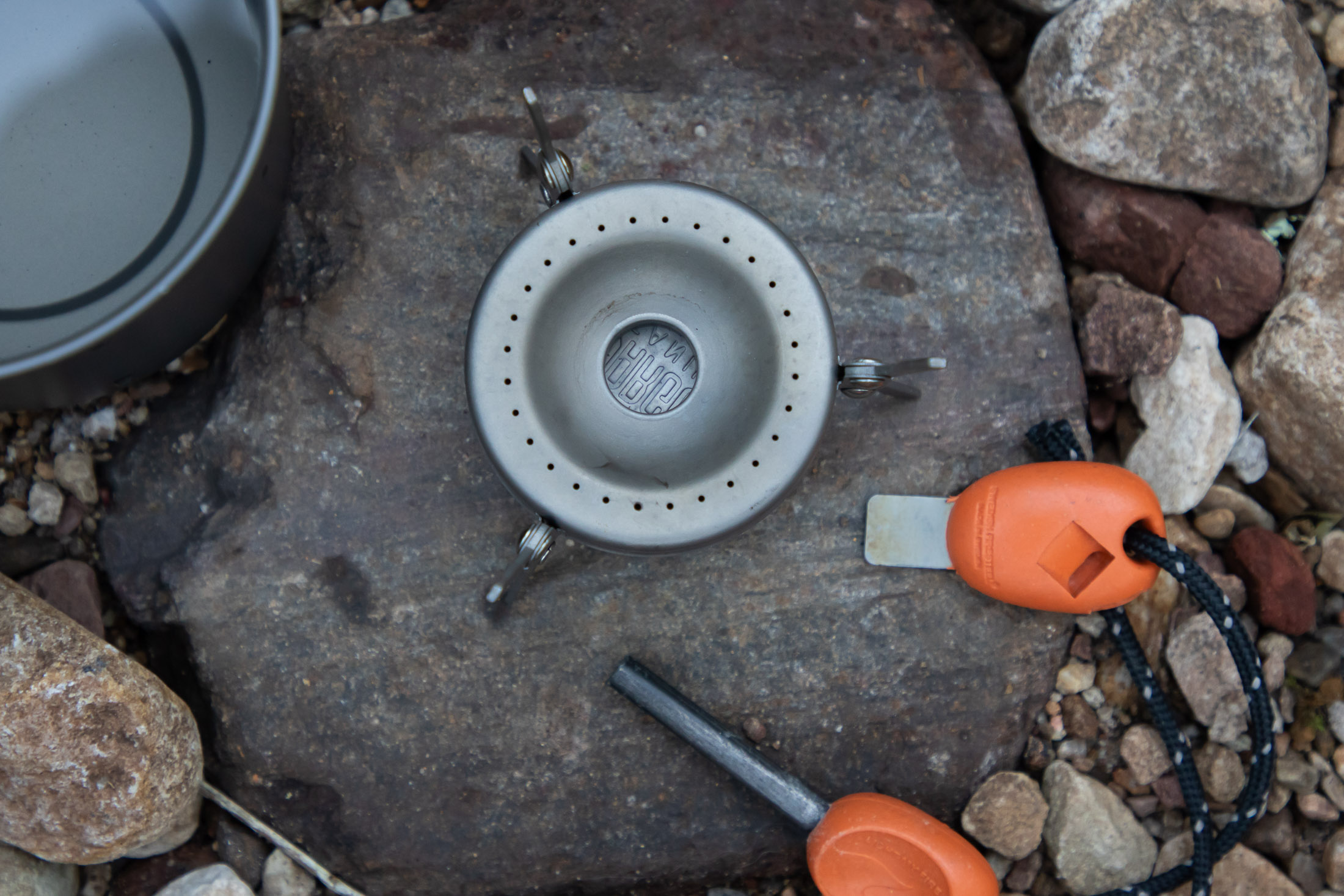
Canister stoves
Canister compatibility
Almost all manufacturers use Lindal valves on their stoves and canisters, so a canister produced by one brand can be used with a stove made by another. Manufacturers recommend using only their canisters, but it’s all pretty much the same stuff.
Warmth for optimal performance and efficiency
If your canister gets too cold, performance and fuel-efficiency suffer. You might want to sleep with a canister if you want a cup of coffee in the morning. If having a cold, metal object in your sleeping bag doesn’t appeal to you, you could also put it in your jacket.
Windscreens
Surrounding your stove with a windscreen can cause the canister to heat up and even explode, so wraparound windscreens are definitely not recommended. However, you can build a wind break. Just make sure that the open downwind side is well ventilated.
Use half empty canisters for car camping
If you’re like me, you want to start most hikes with a full canister, not two half full canisters or even one that is ‘probably mostly full’. If you know that you need a full 227 g canister, grab a fresh one, and use the old one for your next car camping trip.
Foam on snow
When cooking on snow, put a piece of foam underneath the canister to prevent ice from freezing to it. A removable foam backpad also works.
Liquid fuel stoves
Don’t fill the bottle
When refilling a bottle, be sure to leave a little space for the air you need to pressurise. Liquid doesn’t compress nearly as easily as gas, and you won’t be able to pressurise a full bottle.
Use a windscreen
It’s safe to use windscreens with stoves that have remote fuel sources. By shielding your stove from any wind, you’ll speed up boil time and conserve fuel.
Avoid getting fuel on your skin
Besides not being particularly good for your skin itself, the evaporation of fuel on your hands can be so rapid that it can cause frostbite in colder temperatures.
Don’t use old fuel
White gas can degrade over time. If it starts to show a tint of colour, it’s past its prime. If you have to use it, run the fuel through a coffee filter to strain out sediment first.
Servicing
It’s recommended that you service a liquid fuel stove every year, but do that sooner if you notice a reduced fuel flow or an inconsistent flame.
Get more advice from this gearhead
You now know everything you need to know about backpacking stoves. But don’t stop here. On this website you’ll find many more gear guides on everything from headlamps to tents as well as many how-to articles. Find these under the ‘Outdoor life’ section or ‘Gear’ and ‘Skills’ in the sidebar if you are looking for something specific. Alternatively, sign up for my newsletter to get all the latest from Trail & Crag delivered straight to your inbox.
